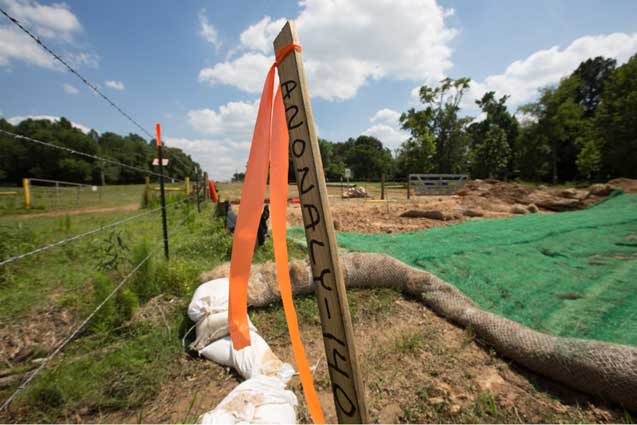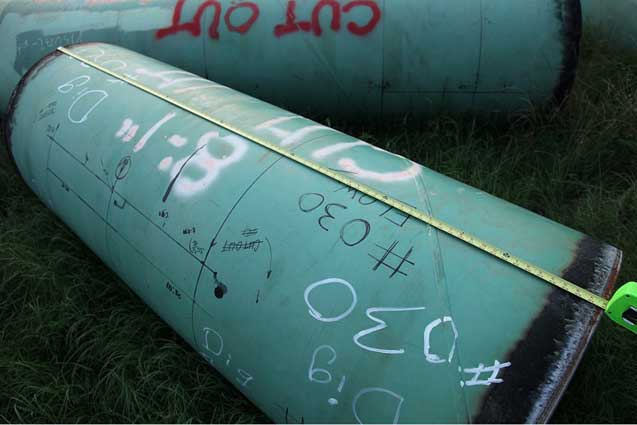
The fight in Texas against the southern portion of the Keystone XL pipeline continues despite its being over 75 percent complete. Pending cases against TransCanada and departments of the US government cite fraud and improper use of eminent domain. The lawsuits allege that the government is serving the best interests of a corporation rather than those of the people it is mandated to protect. Recently, mandatory inspections done with a water pressure test along a portion of the southern route revealed anomalies.
The integrity of the pipeline is now in question. Winnsboro landowner Eleanor Fairchild was the first resident to question what it meant to have TransCanada back on her land digging up flawed pipe. She has pulled back the curtain on this project just as Dorothy did in the Wizard of Oz. In an effort to quash all criticism, TransCanada’s spokesman Shawn Howard in an email to the Longview, Texas, News-Journal said inspections found “small imperfections” in the pipe, and David Dodson, another Trans Canada spokesman, said, “there was no performance issue with the completed portion of the pipeline. Nine spots will be replaced with a minimum of nine feet of pipeline; 81 feet will be replaced in one 80-mile section of pipe.” *
Concerned members of Nacogdoches County S.T.O.P. (nacSTOP) have begun investigations documenting the anomalies. NacSTOP’s findings contradict TransCanada’s assertions about the number of anomalies being removed and their significance. NacSTOP has presented extensive photo documentation showings dents, sags and damage to the pipeline’s coating, and sections of replacement pipe shorter than the mandatory nine-foot requirement TransCanada representative Dodson said was mandated by Texas law. The sags and dents revealed in nacSTOP’s video most likely were caused by failure to follow code mandates to adequately support the pipe. This happens when subsoils are not properly packed in the ditch the pipeline was placed in or where foam pillows were improperly placed to support the pipeline. Also, further damage could have been done if the backfill process wasn’t done according to code.
Code 434.11 Backfilling
Backfilling shall be performed in a manner to provide firm support of the pipe. When there are large rocks in the backfill material, care shall be exercised to prevent damage to the pipe and coating by such means as the use of a rock shield material, or by making the initial fill with a rock-free material sufficient to prevent rock damage. Where the ditch is flooded, care shall be exercised that the pipe is not floated from the bottom of the ditch prior to backfill completion.
 Michael Bishop next to a warning sign put up by TransCanda on his land. He points out the sign is incorrect which could be dangerous in the case of a spill for cleanup personal. The sign says oil pipeline when it is a bitumen pipeline. (Photo: ©2013 Julie Dermansky)
Michael Bishop next to a warning sign put up by TransCanda on his land. He points out the sign is incorrect which could be dangerous in the case of a spill for cleanup personal. The sign says oil pipeline when it is a bitumen pipeline. (Photo: ©2013 Julie Dermansky)
Texas landowner Michael Bishop is fighting TransCanada with multiple lawsuits, including one challenging the US Army Corps of Engineers in a federal class action suit. He alleges the Corps didn’t give Texas equal protection under the Clean Air and Water Act as it did Nebraska, where the Keystone XL route was rerouted away from sensitive aquifers. He also alleges the 57 special conditions recommend by the Pipeline and Hazardous Materials Safety Administration (PHSMA), accepted by TransCanada, are not being met despite claims by TransCanada that they are. PHSMA’s code pertaining to all pipelines is also being broken. The code of construction lays down the law for construction contractors and pipeline owners that must be followed. Bishop contacted PHSMA before TransCanada began construction on his property. “I called PHMSA to see if they could help me and I was told that PHMSA could not get involved or investigate any complaints until product was flowing through the line. The Houston office told me that due to budget constraints and cutbacks, even if they could investigate, they only had three inspectors in the southwest division. They reiterated that construction of pipelines was not in their realm of responsibility and that investigation of complaints could only take place when oil was flowing through the line and not before,” he says.
 Douglas, Texas, February 19, 2103 Keystone XL pipeline being installed on Mike Bishop’s property. Foam is seen floating in the ditch. Had the foam been supporting the pipe properly, rain would not have washed it out. One can only hope Michels supported the pipe properly before backfilling the ditch. (Photo: ©2013 Julie Dermansky)
Douglas, Texas, February 19, 2103 Keystone XL pipeline being installed on Mike Bishop’s property. Foam is seen floating in the ditch. Had the foam been supporting the pipe properly, rain would not have washed it out. One can only hope Michels supported the pipe properly before backfilling the ditch. (Photo: ©2013 Julie Dermansky)
PHSMA is required to inspect the pipeline during installation and is responsible for making sure the land is properly restored according to code developed by the American Society of Mechanical Engineers. PHSMA’s code makes inspections of the pipeline during installation mandatory, not optional, since that is the only way to assure code compliance. Furthermore the Keystone XL project was mandated to supply a project-specific quality manual that details how the regulations and codes will be met.
Code b31.4:
434.12 Restoration of Right of Way and Cleanup
These operations shall follow good construction practices and considerations of private and public safety.
434.3.2 Construction Requirements. Inconvenience to the landowner should be a minimum and safety of the public shall be given prime consideration.
(b) In grading the right-of-way, every effort shall be made to minimize damage to the land and prevent abnormal drainage and erosive conditions. The land is to be restored to as nearly original condition as is practical.
Last year when TransCanada began clearing Fairchild’s land for the pipeline, the 78-year-old grandmother stood with environmental activist Daryl Hannah in the path of land-moving machines sent to dig up her land. She was arrested and labeled an eco-terrorist in a subsequent lawsuit filed against her by TransCanada. Throughout the pipeline development process, Fairchild has been monitoring numerous issues on her land. “I hope what they are doing under the ground looks better than how they have left the surface,” she said. Large crevices created by erosion appeared on Fairchild’s land in January this year. (Video and photo of the crevices and other erosion issues is available here). The grass planted on the easement where trees once stood is not taking hold, in part because the topsoil was not replaced; instead, it was used by Michels, the construction company TransCanada hired to install the pipeline, to build berms meant to prevent erosion.
TransCanada replaced Michels, whose work caused erosion problems, with another company which Fairchild feels is equally inept. They installed a makeshift fix using bails of hay, which do not prevent water from flowing around them. When TransCanada representatives came to see the restoration attempts, Fairchild told them the fixes won’t work. When TransCanada ignored her, Fairchild called the Environmental Protection Agency (EPA) about the erosion problems. “Call the Corps of Engineers,” said the EPA. The Corps told her to call the EPA.
She called PHSMA, which said it had no jurisdiction despite the code, though Fairchild was told PHSMA would look into the anomalies revealed during the inspection. As Fairchild dealt with the stress of having contractors on her land for the mitigation work, she received a letter with her mid-July court date to answer to TransCanada’s charges. Their lawyers offered to drop all charges against Fairchild if she would keep quiet, an offer she refused. “I didn’t do what I did to stay quiet later,” she says.
 Julia Trigg Crawford on her land taking pictures of the pipeline installation while a TransCanda employee films her. (Photo: ©Julie Dermansky)
Julia Trigg Crawford on her land taking pictures of the pipeline installation while a TransCanda employee films her. (Photo: ©Julie Dermansky)
Julia Trigg Crawford is following reports from her south Texas friends about the Keystone XL anomalies as the pipeline is being buried. The Northeast Texas landowner from Sumner near the Oklahoma border was able to delay the pipeline installation briefly, compelling TransCanada to do studies of the value of Indian artifacts in its path. Despite the fact that they unearthed many artifacts, a local government historian signed off on a report saying they are of no significance. Though Crawford’s case charging TransCanada with improper use of eminent domain is still in the courts, she could not obtain an injunction to stop the work. Once the pipeline installation on her land is finished, the link from Texas to Oklahoma will be complete. Each day she walks the length of the easement to document the process with her camera. TransCanada contractors follow her and film her every move. She asked one of the TransCanada reps why they were photographing and filming her. “What purpose other than harassment could there be in doing that?” she asks.
Evan Vokes, a former TransCanada pipeline engineer, recently testified before the Canadian Senate about the company’s lack of code compliance. He has been trying to get the word out that code is not being followed in the pipeline’s construction, and that when that happens, a pipeline cannot be safe for crude oil or tar sands. Vokes fought from within the company for five years to get them to do things the right way. When he saw they would not, he presented evidence of wrongdoing to the National Energy Board of Canada (NEB) before he was fired. TransCanada has put out statements to discredit Vokes, but nothing Vokes has presented as fact has been refuted. In fact, his claims have been verified. Vokes stresses that he is not opposed to pipeline transport of bitumen. Instead, he is against the transport of anything in a pipeline not built to compliance codes. “You cannot have a safe pipeline without code compliance,” Vokes told Truthout.
Vokes believes the discovery of numerous anomalies indicates a failure in the inspection process as the pipeline was being built. He wonders why the pipeline inspectors did not realize there were problems before the pipeline was buried, suggesting there is no way this job has been properly inspected. Bishop said he received an emiling from PHSMA indicating they don’t have the funding to do required inspections; PHSMA did not return Truthout’s inquiries seeking details on how many inspections it has performed during the pipeline’s construction. “If PHSMA does not do their part in the inspection process, we are looking at a pipeline that has been installed before being adequately inspected,” Vokes pointed out.
TransCanada’s Shawn Howard confirmed in an email:
TransCanada agreed to 57 special conditions suggested by the Pipeline and Hazardous Materials Safety Administration regarding the construction and operation of the proposed Keystone XL pipeline. Those conditions also apply to the Gulf Coast Pipeline nearing completion in Texas and Oklahoma. As a result of higher standards and improved detection technology, it should not be a surprise that TransCanada is confident in saying that the Gulf Coast Project will be the safest pipeline ever built. It also stands to reason that more reported indications of surface anomalies are uncovered post-construction under these circumstances.
But the 57 conditions do not change standard code compliance and the inspection test leading to the anomalies being found is standard procedure, according to Dodson in his statement to the News-Journal. The anomalies point to violations of standard code, irrespective of any special conditions.
“We have an absolutely outstanding safety record,” Howard insists. “We have consistently invested in pipeline safety and integrity and in personal and occupational safety.” But facts show otherwise. In May 1996, a subsidiary of TransCanada PipeLines Ltd. and two senior Calgary executives pleaded guilty to numerous violations of US environmental and safety laws in Syracuse, New York (Edmonton Journal May 24, 1996 p. G1). The Bison pipeline in Wyoming, another TransCanada project, had to be shut down after a portion of it blew. Michels was the contractor for the Bison, a project that had problems due to improper backfill causing pipeline failure. Michels could be doing the same thing now in Texas. Vokes told the Wyoming Tribune that speed was put ahead of safety. Getting the pipeline in service has been TransCanada’s top priority.
 Eleanor Fairchild took this during the installation ton process. An industry insider points out the pipe is being bent to lay it in the ditch. (Photo: ©Fairchild 2011)
Eleanor Fairchild took this during the installation ton process. An industry insider points out the pipe is being bent to lay it in the ditch. (Photo: ©Fairchild 2011)
What’s more, the Keystone pipeline that runs from Alberta, Canada, to Cushing, Oklahoma, has been plagued with problems. Leaks have already been reported. In a story on The Huffington Post, Michael Klink, a former pipeline inspector, reported a litany of problems – including low-quality concrete jobs, improperly spaced rebar, bad welds and poor pressure testing – when he was working as a construction inspector at several pumping stations along the line as it was being built in 2009. “I worry that it’s only a matter of time before there will be another disaster like the Deepwater Horizon – only this time it won’t be out on the water,” Kirk says.
From the Natural Resources Defense Council’s online magazine Switchboard, Rocky Kistner writes, “Let’s remember, TransCanada claimed that the Keystone I pipeline system would be one that would ‘meet or exceed world-class safety and environmental standards’ and leak an average of 1.4 times a decade. In just its first year of operation, Keystone leaked 14 times, a hundred times more leaks than TransCanada predicted. On its Canadian side, the pipeline has leaked at least 21 times.”
TransCanada’s CEO Russ Girling disputed Kistner’s findings in a statement on TransCanada’s blog, writing, “We make it clear to all of our employees and contractors that we will not tolerate anything that undermines the safety and reliability of our facilities.”
 A stake marks the stop where an anomaly was found on Curly Choices land in the Waters Bluff community in Smith County. (Photo: ©2013 Julie Dermansky)
A stake marks the stop where an anomaly was found on Curly Choices land in the Waters Bluff community in Smith County. (Photo: ©2013 Julie Dermansky)
Can Keystone XL’s southern route be safe? When segments of pipe are cut out to remove an anomaly, a new segment is welded in. Those welds are know as golden welds, or in the language of the construction code, tie-in welds. They can be safe, but flaws in golden welds are not easy to catch, so each new section introduced into the pipeline adds another potential weakest link in what Girling goes on claiming will be the safest pipeline ever built.
Vokes is not so sure. “My education shows the pipe replacement program with the manual welds used the poorest form of radiography, which has the lowest probability of detection of serious defects. The lack of subsequent pressure test introduces risk of leaks into the system, putting this pipeline in the category of minimum levels of compliance,” he said. “No claim of ‘best’ is justified when we have post-construction golden welds, and this is worse without the use of automated ultrasonics on these replacement girth welds.”
“There was a time to deal with enforcement of quality during construction, and this does not appear to have happened,” Vokes continued. “Without code compliance, one must consider compliance vs. risk, and you can’t play risk with the code.”
 A section of pipe cut out due to an anomaly measuring less the 9ft. TransCanada claimed they could remove 9ft of pipe at every site they cut out. (Photo: ©NagSTOP 2013)
A section of pipe cut out due to an anomaly measuring less the 9ft. TransCanada claimed they could remove 9ft of pipe at every site they cut out. (Photo: ©NagSTOP 2013)
There is no tried and true way to contain a tar sands spill or clean it up. The people who live on the banks of a creek that feeds into the Kalamazoo River, site of the Enbridge oil spill, are well aware of that fact, as are residents of Mayflower, Arkansas, who suffered a spill from Exxon’s Pegasus pipeline. Some landowners who signed over use of their land to TransCanada would not have done so if they knew tar sands, not crude oil, was in the pipes. Much of what TransCanada told the landowners is fraudulent, according to several lawsuits now pending.
TransCanada was recently compelled to release a document it produced for Nebraska’s law enforcement officers that attempts to label activists in the Tar Sands human blockade as eco-terrorists. Ron Seifert, a spokesperson for the activist group Tar Sands Blockade, said, “If TransCanada is willing to lie to a room full of police officers about the peaceful nature of KXL protesters, it follows that it would lie to a room full of regulators about safety and workmanship. This corporation simply cannot be trusted.” Vokes delivered evidence of TransCanada’s lies during the Canadian Senate hearings and supplied documentation to PHMSA, as well.
The evidence is available for the State Department to review. The very agency that recommended the 57 special conditions needed to assure the pipeline’s safety has not been regulating the installation process of the southern portion of the pipeline. If president Obama signs off on Keystone XL, his legacy could well be stained by tar sands.
*TransCanada representative Shawn Howard said they are circling back on the comment Dodson made to the press about removing segments measuring nine feet of pipe. The correct amount they are required to remove is eight feet, according to Howard. NacSTOP has documented segments of pipe less than eight feet.
Our most important fundraising appeal of the year
December is the most critical time of year for Truthout, because our nonprofit news is funded almost entirely by individual donations from readers like you. So before you navigate away, we ask that you take just a second to support Truthout with a tax-deductible donation.
This year is a little different. We are up against a far-reaching, wide-scale attack on press freedom coming from the Trump administration. 2025 was a year of frightening censorship, news industry corporate consolidation, and worsening financial conditions for progressive nonprofits across the board.
We can only resist Trump’s agenda by cultivating a strong base of support. The right-wing mediasphere is funded comfortably by billionaire owners and venture capitalist philanthropists. At Truthout, we have you.
We’ve set an ambitious target for our year-end campaign — a goal of $180,000 to keep up our fight against authoritarianism in 2026. Please take a meaningful action in this fight: make a one-time or monthly donation to Truthout before December 31. If you have the means, please dig deep.